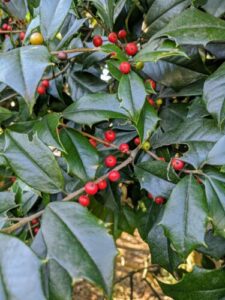Here are 7 facts about the American Holly tree:
- The American Holly tree is a slow-growing evergreen tree that can reach a height of up to 50 feet (15 meters) and a spread of up to 25 feet (7.5 meters).
- It is native to the eastern United States and is commonly found in forests, swamps, and along streams.
- The American Holly tree has a pyramidal shape and dense foliage of glossy, dark green, spiny leaves. The leaves have a waxy coating that helps protect them from moisture loss.
- The tree is dioecious, which means that there are separate male and female trees. The female trees produce bright red berries that are popular with birds and other wildlife.
- The American Holly tree is a popular ornamental plant, often used in landscaping for its attractive foliage and bright red berries.
- The wood of the American Holly tree is white and hard, making it a popular material for inlay work, carving, and turning.
- The tree has also been used in traditional medicine to treat a variety of ailments, including fever, rheumatism, and heart disease.
7 Facts About The American Holly Tree
The American Holly tree is also an important cultural symbol, often associated with Christmas and winter holidays in the United States. It is often used to make wreaths, garlands, and other holiday decorations.
HOW TO GROW AND CARE FOR AMERICAN HOLLY TREES

American holly trees are a popular ornamental evergreen tree, known for their dark green foliage, red berries, and attractive shape. Here are some tips on how to grow and care for American holly trees:
- Planting: Choose a well-drained site with acidic soil, ideally with a pH of 5.0-6.5. American holly trees prefer full sun to partial shade and are tolerant of a range of soil types.
- Watering: Water young trees regularly during the first growing season, aiming to keep the soil moist but not waterlogged. Once established, American holly trees are drought-tolerant and do not need as much watering. 7 Facts About The American Holly Tree
- Fertilizing: Apply a balanced, slow-release fertilizer in the spring, following the manufacturer’s instructions. Avoid fertilizing in the fall, as this can encourage new growth that is more susceptible to winter damage.
- Pruning: Prune American holly trees in late winter or early spring to remove dead or damaged branches and to shape the tree. Avoid heavy pruning, as this can reduce the tree’s berry production.
- Pest and disease control: American holly trees are generally resistant to pests and diseases, but may occasionally suffer from leaf spots, scale insects, or spider mites. If you notice any issues, consult with a professional arborist or local nursery for appropriate treatment options.
- Mulching: Apply a layer of mulch around the base of the tree to help retain moisture and control weeds. Avoid piling mulch up against the trunk, as this can cause rot.
- Winter protection: American holly trees are hardy in USDA zones 5-9, but may require winter protection in colder areas. Cover the tree with burlap or another breathable material to protect it from wind and snow damage.
7 Facts About The American Holly Tree
By following these tips, you can successfully grow and care for American holly trees and enjoy their beauty for years to come.
American Holly is a beautiful, evergreen tree that is native to the eastern United States, including Kentucky. It is known for its dark green, glossy leaves, and bright red berries, which are a favorite food of birds in the wintertime.
The American Holly tree can grow up to 50 feet tall, with a spread of up to 25 feet. It has a dense, pyramidal shape when young, which becomes more rounded with age. Its leaves are oval-shaped, with a smooth, glossy surface and spiny margins. The tree’s bark is gray-brown and smooth when young, becoming rough and fissured as it matures.
In addition to its ornamental value, American Holly has long been valued for its wood, which is used for a variety of purposes. It is hard and dense, with a fine grain, and is prized for its strength and durability. Wood is used to make furniture, cabinets, and other decorative items. It is also used for tool handles, engraving blocks, and musical instruments.
7 Facts About The American Holly Tree
American Holly has a rich cultural history as well. It has long been associated with Christmas, and its branches and berries are often used in holiday decorations. In some Native American cultures, the tree was used medicinally to treat a variety of ailments, and the bark was used to make a tea that was believed to have healing properties.
Unfortunately, American Holly is threatened by habitat loss and over-harvesting. In some areas, it is also affected by a disease called holly leaf spot, which causes yellowing and premature leaf drop. Conservation efforts are underway to protect and preserve this beautiful and important tree species.
In conclusion, American Holly is a beautiful and valuable tree species that has played an important role in American culture and history. Its ornamental value, wood, and medicinal properties make it an important part of the natural and cultural landscape of Kentucky and the eastern United States.


